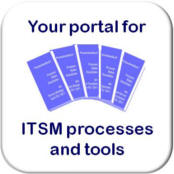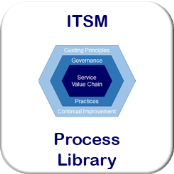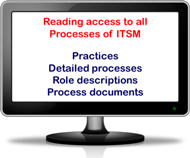Home Imprint Terms/Data Protection FAQ ITSM Wiki Affiliate Program

.... ITSM Wiki ....
Documents of IT Service Management
according to ITIL® and ISO 20000
The processes of IT Service Management are guided by a controlled information flow. It contains a number of standardized process documents described here. A great amount of these documents pass more than one ITSM discipline, which makes a classification by the disciplines confusing. Hence they are presented here in alphabetical order.
A B C D E F I K M O P R S T U W
- A -
Actual Costs are period related expenses of the (part of the) organization or a project.
Availability Management Report
The Availability Management Report informs the other ITSM functions about the availability of IT Services and IT Infrastructure.
The Availability Plan contains information about active and planned activities for adaption of the availability of the IT Services and IT Infrastructure to the requirements of all fields of IT Service Management and the IT Service Consumers under economic aspects.
- B -
The Budget Requirement describes the budget period related prognosis of expected costs and revenues of the requiring business unit respective project.
The Business Continuity Strategy describes the arrangements for the retention respective fastest possible re-establishment of business critical processes of the company in case of disaster. It is part of the company strategy and provides important input for the IT service continuity strategy.
- C -
The Capacity Forecast contains the anticipated capacity demand per IT Service based on Service Level Agreements and demand trends.
The Capacity Management Report contains all relevant information about usage and performance of the IT Services and IT Infrastructure.
The Capacity Plan contains the prognosis of the future Capacity Demand per IT Service and evaluated possible activities to provide these required Capacities.
The Change Evaluation Report documents the results of the different steps of Change Evaluation:
-
prior to planning
-
prior to realization
-
prior to rollout
-
after rollout.
The Change Information contains all information worth knowing about planned and ongoing Changes, especially Planned Service Outages provided for the other ITSM Disciplines and the IT Service Consumers.
The Change Management Guideline (Change Policy) contains the rules for intake, evaluation, prioritization and approval of Changes (Change Release Hierarchy) either by the Change Manager or the Change Advisory Board (CAB), the handling of Emergency Changes by the Emergency Change Advisory Board (EACB) and the validation and documentation of Changes during Post Implementation Reviews (PIR). Additionally the rules for extensive Changes that have to pass the processes of Change Evaluation are documented here.
The Change Management Report informs all IT Service Management Disciplines about the status of actual and planned changes and the results of the post implementation reviews and the derived improvement and optimization proposals.
Change Models define the content and the procedure for Standard Changes. These are pre-approved Changes with low risk.
The Change Release Hierarchy defines who is entitled to release (approve) a submitted Change depending on its criticality (risks). The Change Release Hierarchy is part of the Change Management Guideline.
The Change Record is based upon the Request for Change and documents the complete life cycle of a Change.
The Change Schedule (Forward Schedule of Changes) contains the planning of all approved Changes including their accompanying information and dependencies.
Configuration Items are the operating resources of the IT services in general. They are maintained within the Configuration Management Database (CMDB), which itself is a core component of the Configuration Management System.
Configuration Management Audit Protokoll
The report of the audit of the Configuration Management System (Configuration Management Audit Protocol) informs about the results of the Configuration Management Audits including
-
detected differences between the Configuration Item Records and installed Configuration Items
-
evaluation of the usefulness of the structure of the Configuration Management System
-
actuality and completeness of the Definitive Media Library.
Configuration Management Guideline
The Configuration Management Guideline defines who is entitled to change the structure and the content of the Configuration Management System.
Criticality Status from Business Perspective
The Criticality Status from Business Perspective describes the relevance of proper function of
-
IT services
-
IT infrastructure services
-
IT infrastructure
from the view of importance for the company business. The means for that purpose is the Service Landscape.
Criticality Status from IT Perspective
The Criticality Status from IT Perspective describes the relevance of proper function of
-
IT services
-
IT infrastructure services
-
IT infrastructure
from the view of recognized threats and weaknesses of the IT Infrastructure.
The Continual Service Improvement Register (CSI Register) is the basis for all potentials and initiatives for the improvement of the service quality over the service life cycle. In the cyclic CSI Register all activities to improve the service quality are documented.
The Customer Portfolio contains information about all customers of the IT Service Provider over the customer's lifecycle from the Business Relationship Management's perspective (comparable to CRM).
- D -
The Definitive Media Library is the infrastructure (locations and storage equipment there) where the latest versions of released Software Configuration Items are stored in a protected environment. This also includes software licenses and documentations. Asset and Configuration management is responsible for the Definitive Media Library while the content is maintained by Change and Release Management. It is documented in the Configuration Management System.
The Delivery Documents contain product documentations, installation instructions, aso. besides the delivery note as specified within the purchase order.
The Demand Prognosis provides a forecast of the future demand for IT Services based upon the IT Service Strategy, requests from the IT Service Consumers and historic consumption trends.
Design Recommendation for High Availability
The Design Recommendations for High Availability define inputs for procedures and design characteristics for the Service Design required for high availability of the IT Services and IT Infrastructure.
The Desired Service Outcome desribes the expected results of an IT Services with the words of the customer. Based upon this information detailed documents describing the requirements exactly in technical terms of the Service Provider are created.
The Disaster Guideline contains procedures for the handling of disaster situations:
-
call-up plans
-
emergency procedures
-
preventive procedures
-
aso.
The Disaster Practice Report documents the planning for, the execution and the results of Disaster Pratices and containes proposals for detected improvement potentials of the Contingency Planning.
- E -
An Emergency is a complex breakdown of IT Systems and / or IT Services, e.g.:
-
complete breakdown of one or more IT Systems
-
blackout of a subsidary caused by damage or ruin of IT Infrastructure
-
disaster situations.
Emergency Procedures define all activities for the fastest possible restore of operation of IT Systems after emergency situations (disasters, complete breakdown of IT Services or locations, aso.). This restore has normally two steps:
-
recovery of a life - sustaining minimal operation
-
recovery of full operation.
The Event Correlation describes the relations between events and necessary operational interventions respective necessary error messages. The rules for the Event Correlation define the appropriate reaction to an Event.
Message about a recognized malfunction of an IT System or an IT System Component from Event Management.
The Event Record describes relevant status changes from the operation of IT Services and IT Infrastructure Components. They may be status changes but also alarm situations.
The Event Statistics shows patterns and trends of Events and allows an analysis of the efficiency of the Event Recognition.
Automated notification of the Service Desk System about a recognized malfunction of an IT System or an IT System Component from Event Management.
- F -
The Forecast describes an extrapolation of economic results based upon actual costs and revenues of previous periods within the budgeting period to the end of this budgeting period.
- I -
The Improvement Report provides information about planning and results of Continual Service Improvement for the other IT Service Management functions. It contains planned, actually executed and since the last report finished service- and process improvement activities and their expected respective achieved results. Furthermore proposals for future additional service improvement activities are provided.
The Escalation Rules for Incidents define the hierarchy levels for escalation of an Incident and the triggers therefore.
The Incident Management Report informs all involved ITSM Disciplines about occured Incidents and their elimination.
The Incident Management Report informs all involved ITSM Disciplines about occured Incidents and their elimination.
Incident Models describe the predefined activities to handle known and recurring types of Incidents and their effective and efficient elimination.
The Incident Record contains all information about an Incidents over ist lifecycle. Typically it is documented in the Service Desk System.
An Individual IT Service requires normally changes of underlying basic IT Services or Infrastructure Services. Thus an important focus on the functional and organizational requirements specification is necessary.
The IT Budget is a rolling business period related financial plan containing a prognosis of expenses and revenues to be expected for the IT Organization. Within the IT Budget funds are allocated to the processes of the IT Service Management respective to the organizational units of the IT Service Provider.
The IT Financial Report documents costs, revenues and contribution margins of IT services, the costs of IT System Operation allocated to the IT Services and provides a forecast to the development of the financial performance indicators.
The IT Forecast provides a projection of the economic results (of individual IT Services or the complete IT Organization) to the end of the budgeting period based upon actual costs and revenues of previous periods.
The IT Operations Schedule contains the planning of all recurring activities for the maintenance of operation for the IT Systems and a friction free IT Operation:
-
system specific planning of backups
-
reorganisation of IT Systems
-
system maintenance
-
data cleansing
-
data archiving
-
batch jobs
-
aso.
The IT Procurement Guideline specifies the terms and conditions for requesting external IT Supplies and IT Services for the Demand Carriers and for providing such Supplies and Services for the suppliers. It contains beside others
-
a register of standard suppliers for IT Supplies and IT Services
-
a catalogue of standard supplies and services with respective procurement terms and conditions.
During a purchasing activity it is supplemented by the common procurement terms of the company.
The IT Purchasing Requisition is the defined ready to process order to buy according to the IT Requirements Request with specified scope of supply and specified supplier.
An IT Requirements Request represents an application for procurement of services and/or goods from external suppliers of the IT. The IT Requirements Request describes the contents of the demand and is transformed into a definitive purchasing requisition within the IT Procurement Process.
The IT Security Guideline defines mandatory rules for the utilization of IT Services and IT Systems for maintenance of an appropriate security level and for security controls.
The IT Security Strategy defines the procedures for assuring the security of IT Services and IT Systems regarding the recognized relevant risks and the planned and implemented according Security Controls. The operational procedures and mandatory behaviours thereto are defined in the IT Security Guideline.
The IT Service Continuity Report informs about the actual status of Contingency Planning and the actual emergency procedures.
IT Service Continuity Strategy
The IT Service Continuity Strategy defines procedures for desaster scenarios including risk prevention activities and restoring procedures for business critical processes and their systems support. Thus it is a major input for the Business Continuity Strategy of the company.
The IT Supplier Strategy describes the rules for the selection of suppliers for IT Supplies and IT Services and the frame conditions for such supplies.
- K -
A Known Error is a Problem whose cause is known and documented including a documented workaround (as far as available).
- M -
A Major Incident is an Incident with serious negative impact on the business activities of the company.
A Minor Release is a Release with low risk according to the following criteria:
-
not business critical
-
no data take - over required
-
no involvement of Service Validiation and Test required
-
no acceptance test by the user required.
- O -
Operational Tasks are routine tasks to maintain friction free operation of IT services:
-
backup
-
data cleansing
-
reorganization of IT systems
-
archiving
-
necessary batch processes
-
print services
-
aso.
An offer is an obligatory declaration of preparedness to deliver services or goods in defined amount and design with also defined prices and delivery conditions.
The Operational Level Agreement provides an internal contract between the IT Service Proivider and another part of the IT Organization regarding the provision of an IT Service Contribution. It defines besides others:
-
a description of the service contribution
-
the service level goals
-
the mutual responsibilities.
- P -
Planned Service Outages due to the implementation of Changes by Service Transition. These Planned Service Outages are normally within the maintenance time frames according to the Service Level Agreements and thus do not reduce the contractual agreed Availability of the respective IT Services.
The Problem Management Report informis all involved ITSM Disciplines about open Problems and Problems in process and the related solutions and workarounds.
The Problem Record contains all information of a Problem over ist lifecycle. Typically it is documented in the Service Desk System.
The Process Architecture documents the process landscape of the IT Service Provider with all interfaces and process performance indicators to ensure friction free collaboration of all processes.
The Process Design describes a process in total with
-
responsibility
-
input
-
output
-
process steps (activities)
-
interfaces
-
process metrics.
Process designs follow the requirements of the process architecture and the process management.
The Process Evaluation Report documents the results of the Process Evaluation Reviews with (as appropriate):
-
process maturity
-
benchmarks
-
weaknesses
-
potentials for optimization.
The Process Performance Report documents the values for the performance indicators defined for the process on a periodical basis compared with the defined goals.
The Project Order contains the relevant description of the project:
-
project name
-
principal
-
project start and end
-
short description, business demand and goals
-
expected project results
-
project budget
-
project manager
-
project team (resources)
-
assumptions and limitations
-
resource allocation
-
target deadline.
Approval of the Project Order is the start of the project realization.
The Purchase Order is the binding order to the supplier to deliver the goods and/or services specified in the purchase order under the conditions described there respective in accompanying related documents.
- R -
Notification of defects due to unsufficient or not contract conforming delieveries and services. Possible consequences are rework, claim and cancellation of order.
Recommendations for Demand Control
Trigger for the optimization of service consumation behaviour as input for the Demand Management.
Recommendations for Process Quality Improvement
Trigger for the optimization of the quality of IT processes as input for the process review.
Recommendations for Service Quality Improvement
Trigger for the optimization of the quality of IT services and IT infrastructure services by changes in
-
service level agreements
-
operational level agreements
-
underpinning contracts
as input for the service review.
The Recovery Plan describes activities and procedures for the restart of IT Services after emergency situations referring to Emergency Procedures.
The Release Guideline describes the organizational and technical rules for the transfer of a Release to the production environment regarding the criticality and priority of the Realeases to ensure an optimal approach.
The release package contains all configuration items belonging to the respective release. Those configuration items may be
-
hard- and software components
-
IT infrastructure services
-
IT applications
-
aso.
The Release Record documents the complete lifecycle of a Transition Project.
Notification of a detected malfunction of an IT System respective IT System Component within a externally provided IT Service respective IT Service Contribution to the external supplier.
The Request for Change is a formal request to perform a Change required for all types of Change not defined as release free Standard Change.
The Request for User Account is an application for installation of an user access within an IT System. This installation requires an authorization by a respective user role and the availability of licenses for the involved IT system as well.
The Risk Log is a rated catalogue of identified risks and accordingly defined activities for minimization and mitigation.
Message about recognized necessary activities from Risk Management.
- S -
A Security Alert serves as initial information about newly recognized or even actually ocurred security threats, providing the possibility to avoid or defend the threat for the receiver.
The Security Control Report documents the results of performed Security Controls.
The Security Management Report provides information about security relevant ocurrences and activities and about the security situation of the IT Organization.
The Service Acceptance Criteria describe the criteria against which IT Services and IT Infrastructure Services are checked prior to release to operation according to the underlying Service Arrangements (Service Level Agreement, Operational Level Agreement, Underpinning Contract). Thus the conformity of these Services or Service Contributions with qualitative and functional requirements is assured.
The Service Catalogue is the part of the Service Portfolio (see there) visible for the IT Service Consumers. It contains a complete listing of all active IT Services of the IT Service Provider including those released for deployment.
A Service Contribution is a necessary part of the provision of an IT Service (a Business Service), normally IT Basic or Infrastructure Services necessary to fulfill the Service Level Arrangements of the IT Services part of which they are.
The Service Design Guideline contains necessary rules and regulations
-
for consistent implementation of Service Designs
-
for the decision which changes and projects require formal Service Design
-
which roles have to be involved in the phase of Service Design.
The Service Design Package describes the requirements to the development of IT Services based upon Service Level Requirements. It contains the requirements from the customer's perspective and describes how they will be realized from technical and organizational perspective.
The Service Design Planning contains all relevant activities of the service design phase.
The Service Documentation contains the complete description of the IT Services including all documentation needed for operation, maintenance and further development. This includes besides others:
-
development documentation
-
user documentation
-
functional descriptions
-
maintenance plans
-
maintenance processes.
The Service Landscape documents the relations between Business Services and IT Services at one hand and the relations between IT Services and IT Infrastructure at the other hand. Thus it assures the logical link from Business Service down to Configuration Items. Furthermore it is the basis of a holistic Risik Management for the IT Services with the aspects:
-
criticality from business perspective
-
criticality from technology perspective
-
criticality from resource perspective.
The Service Level Agreement defines the mutual contractual requirements regarding the IT Service. This contains besides others:
-
service description
-
entitled Service Consumers
-
service level goals
-
mutual responsibilities.
Service Level Arrangements cover all service level relevant agreements and contracts:
-
service level agreements
-
operational level agreements
-
underpinning contracts.
Service Level Arrangements Catalogue
The Service Level Agreements Catalogue contains all actual Service Level Contracts including:
-
service level agreements
-
operational level agreements
-
underpinning contracts
referring to the IT Service Consumers.
Service Level Management Guideline
The Service Level Management Guideline contains all rules and templates for the definition and release of agreements for IT Services.
The Service Level Report informs about the agreed service quality of the Service Providers respective Suppliers comparing the agreed and achieved Service Levels. The report furthermore provides information about the utilization of the IT Services, ongoing activities for Service Improvement and extraordinary ocurrences.
The Service Level Requirement contains all requirements to an IT service from the business perspective of the IT Service Consumer. It defines besides others:
-
service requirements
-
service level goals
-
mutual responsibilities.
During service designs the service level requirement is the basis for the service contract and the service level agreement.
The Service Portfolio contains a complete listing of all IT services of the IT Service Provider:
-
current IT services (contractual requirements defined by service level agreements)
-
new IT services under development
-
disabled IT services.
Visible for the IT Service Consumer is the service catalogue (see there) as subset of the service portfolio.
Not visible for the IT Service Consumer are:
-
IT service contributions defined by operational level agreements
-
IT service contributions defined by underpinning contracts (external supplies defined by supplier contracts).
Request from an IT Service Consumer or from an IT employee for:
-
standard change
-
user permissions
-
data recovery
-
information
-
consulting.
The Service Review Report documents the results of the service evaluation reviews with
-
weaknesses
-
technical and economical optimization potentials.
The Service Transition Plan is the project plan mandatory and released for all ITSM Disciplines involved in Service Transition including results-, milestone-, activity-, resource- and cost planning.
Service Portfolio Review Report
The Service Portfolio Review Report contains all organizational, technical and economic outcomes of the Service Portfolio Review. It is an essential input for the strategic evaluation of the IT Services.
Systematic, cyclic and operationalized long range planning of the goals of the IT Service Provider and for the IT services.
A Standard Change is a low risk recurring change, which does not need a explicit release by the Change Manager beeing genarally released. Each standard change is described in a change model.
A Standard IT Service needs normally no change of the underlying IT Basic Services and Infrastructure Services. Thus the process of requirements specification is concentrating on the definition of service level goals and their control.
The Standard Operating Procedures contain the rules for recurring standard activities of the IT Operation and the according targets for these activities and processes.
The Standard Service Catalogue beeing a part of the Service Catalogue contains all Services predefined by supplier contracts thus not needing envolvement of Service Level Managements in case of demand.
The Supplier Profile describes the requirements to suppliers for a specified demand as basis for the supplier selection for the procurement activity satisfying this demand.
The Supplier Service Level Report desribes the achieved performance of suppliers compared to the agreed performance described in supplier contracts or purchase orders. Furthermore the recognized weaknesses and activities to improve performance or even possible contract cancellations form the Supplier Reviews are documented.
- T -
Tactical Charge Rates are used for demand control by financial means.
Test models define the whole tests (timeframe, content, scope) of a Release Deployment to the production environment.
The Transition Management Report contains information about all active and planned Transition Projects (status, milestones, finish).
- U -
An Underpinning Contract is a contract between the IT Serviceprovider and an external service supplier about the provision of service contributions. It defines besides others:
-
description of the service contribution
-
service level goals
-
mutual responsibilities.
Proactive information of the IT Service Consumers about
-
the status of his incident message
-
his/her service request
-
ocurrences influencing the availability of the consumed IT services
-
other miscellaneous information needs.
The User Permission grants a defined scope of access to defined IT services or IT systems.
The User Record contains the system specific permissions of an user besides the identifying basic data.
The User Role describes the correlation of business oriented roles of users and the corresponding defined user permissions in IT Systems.
- W -
A Workaround is a bypass solution for an incident or a problem, where no cause eliminating solution is available so far. Goal of the workaround is to reduce or avoid the effects of the incident respective problem until a final solution is available.
Workarounds for incidents without related problem record are documented in their incident record, while workarounds for problems are documented in the known errors database.






